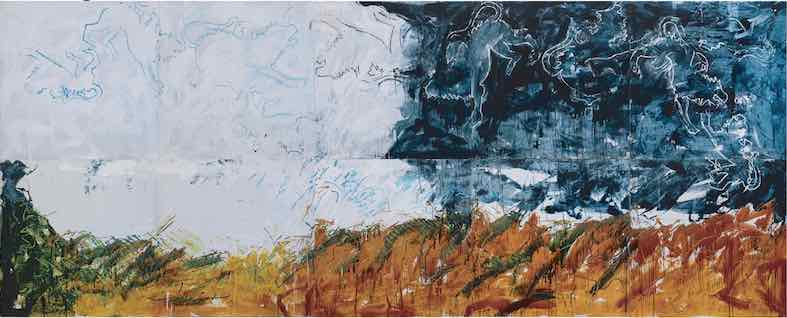Mario Schifano at the Meeting Rimini

Mario Schifano at the Meeting Rimini. One of his most monumental works (10 meters by 4), entitled La Chimera, will arrive at the end of August, in the context of the exhibition “NOW NOW. How a work of art is created ", a project by Casa Testori, curated by Davide Dall’Ombra, Luca Fiore, Giuseppe Frangi and Francesca Radaelli.
Schifano's work, performed live in front of an audience of 6 thousand people, on 16th of May 1985 in Piazza SS. Announced in Florence, the occasion is the inauguration of the year of the Etruscans.
It’s all a right introduction for a path on its way to take on a main aspect of a contemporary art that is infact born NOW , right at this moment The visitor of the exhibition has the opportunity to see seven young artists that are working on creating a work characterized by a final completion, meaning there will be visible changes day by day till it’s all finished.
The seven artists, who use very different techniques and languages, transfer their studios to the fair, exposing themselves to visitors, their looks but also their questions and observations. It is, as far as we know, an experiment never done before, at least with these numbers and performativity and intensity, which goes beyond the concept of participatory art, overcoming the risk of voyeurism, or the Big Brother effect, thanks to a component of interaction that will certainly not be lacking anything, and all that thanks to moments of interaction with visitors, and also daily public conversations, to which a special area is dedicated in the exhibition.
This is how Elena Maria Canavese (Milan, 1989) mounts her photographic ideas inspired by the everyday life, so that the small domestic objects recounts the stories and images of the universe. from the universe in a kitchen to the kitchen of the universe. Danilo Sciorilli (Atessa, CH, 1992) emphasizes the meaning of existence in relation to its inevitable end: he tells it with the help of video animation that brings it to life and with the unprecedented transformation of some serious games of our youth. Alberto Gianfreda (Desio, MB, 1981) presents his sculptures of shattered and recomposed ceramics to become changeable and moving: to the human history that has always animated his work, the metaphorical struggle of the animal kingdom is now added. Elisa Muliere (Tortona, 1981) is responsible for bringing painting to light, with its informal and poetic energy, intent on translating the notes of an obsessive contemporary music into colors and shapes. Alberto Montorfano (Como, 1984) declines his graphite trait, in a continuous overlap of faces, taken from direct photographic shots: a recording of the flows of the "people" of Rimini that questions himself on multiple image and identity. bn + brinanovara, in the century Giorgio Brina (Milan, 1983) and Simone Novara (Milan, 1984), with maps of foam rubber, fabric and white carrara marble, spread day by day behind a pair of melting ice idols, tell the likely story of an Iceberg pointing to the latitude of Rimini, exemplifying to the visitor how difficult it can be to achieve simplicity. To complete the team could not miss the video language, thanks to Stefano Cozzi (Segrate, MI, 1989), who realizes an artistic short film of the same exhibition, documenting it in a video that will grow day by day, from the arrival of the artists to the conclusion of the works.
This exhibition completes a trio of exhibition projects that Casa Testori has curated for the Meeting Rimini, with the aim of bringing the public closer to Contemporary Art (Keeping the fire alive. Surprises of contemporary art, 2015 and Il passaggio di Enea. Today’s artists face to face with the past, 2017, the latter is achieved by showing the works of Andy Warhol, Michelangelo Antonioni, Emilio Isgrò, Alberto Garutti, Giovanni Frangi, Adrian Paci, Wim Wenders, Andrea Mastrovito, Gianni Dessì). The goal was to share the beauty and necessity of today's artistic expression with a broad pool of people of all ages and backgrounds (in previous editions, visitors were over 20 thousand). Compared to that of the past, Contemporary Art probably requires a greater availability of listening on the part of the visitor and requires honest interaction which the curator has the duty to offer. The fact is that the first two exhibitions proved to be able to give the public important opportunities to get to know their present, often thanks to an unexpected empathy of desire.




